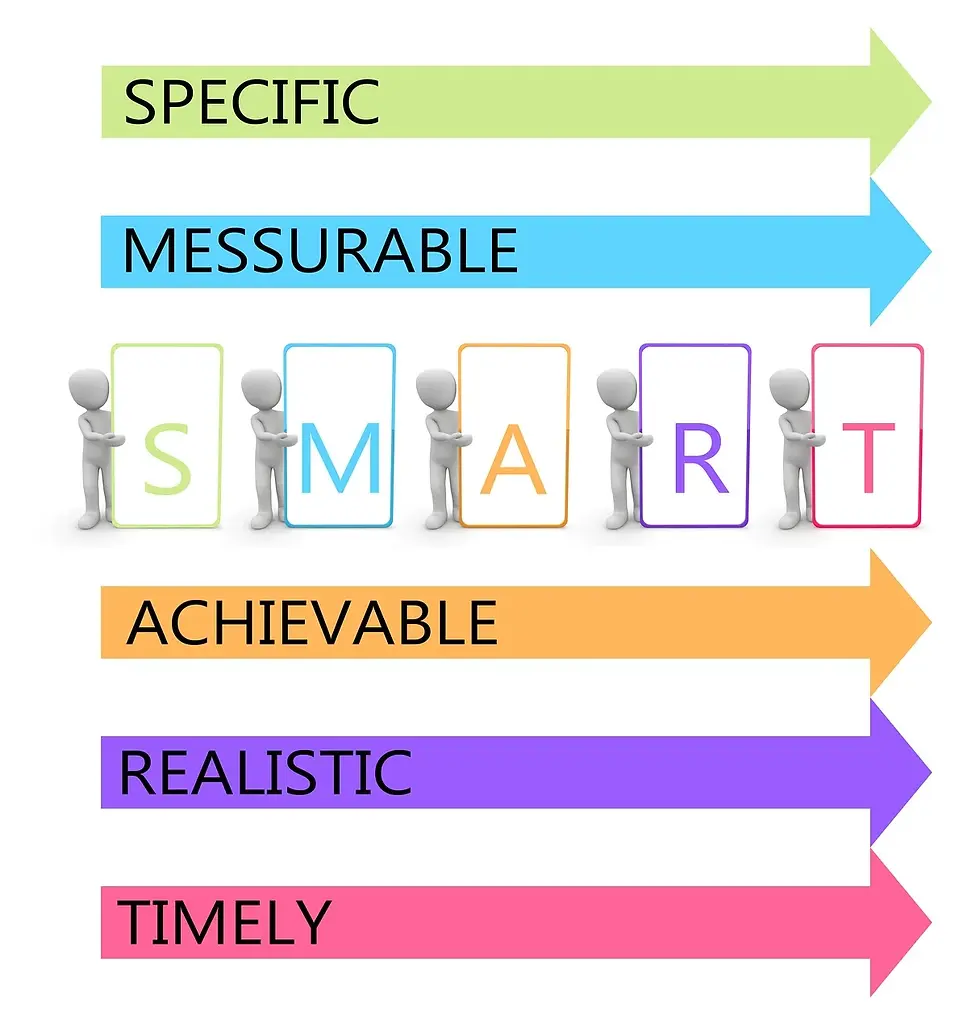
In this series so far, we have learned about goals, goal setting, their benefits and the different types of goals. Now we are ready to learn how to write effective and achievable goals. First we will look at the principles of goal setting for successful goal achievement from Locke & Latham.
The 5 Principles of goal setting:
· Commitment- the degree to which we are attached to a goal and our determination to achieve it, even when faced with obstacles.
· Clarity- specific goals set you on a clear course. When a goal is clear in your mind, you have an improved understanding of the task at hand and you know exactly what is needed to achieve it.

· Challenge- when we feel challenged we will improve our performance through increased self-satisfaction and we have the motivation to find the needed strategy to push our skills to the limit.
· Task Complexity- be sure the time-scale for a goal is realistic, allow sufficient time to work towards the goal and allow opportunities to reassess the complexity while reviewing your performance.
· Feedback- getting feedback, even internal feedback, helps us to determine to what degree a goal is being met and how we are progressing. When we feel our progress towards a goal is adequate, we feel capable of learning new skills and setting more challenging goals for the future.
How to set goals

SMARTer Goals:
· Specific- focus on one area with a clear outcome
· Measurable- quantify or have a progress indicator
· Achievable- know and have ready what you need to make it happen
· Realistic- possible to achieve given your skills and resources
· Time-specific- have a target date and timeframe to achieve your results
· + er: Dig into the main reason ‘why’ you want this specific goal
This can be achieved with asking yourself ‘why?’ five times. Every time you ask yourself ‘why’ you are getting to the heart of why you started this goal in the first place.
11 Personal goal setting tips:
· Brainstorm to determine your SMARTer goals-consider your passions, what inspires you and what your values are. Your goals should be meaningful to you and inspire pride when you achieve them.
· Set goals you can control. Your personal goals shouldn’t be dependent on other people. They also shouldn’t be reliant on external factors that you have no control over.

· Imagine your future- take some time to really think about what you’d like your life to look like. What does your ideal future entail? Be sure to connect your goals to your purpose in life to give them more meaning.
· Be optimistic with your goals, but also realistic to not discourage yourself along the way.
· Next break these large goals down into smaller targets that you need to achieve to reach the lifetime goal.
· Then create an action plan which gives time tables for each target, possibly identifies any resources or additional trainings you need and identifies sources for support.

· As an alternative- You can create a goal tree to organize your end goal/big picture goal on top, then a maximum of 5 objectives or short-term goals that are necessary to achieve to end goal on the next layer, finally branching into the needed conditions or tasks to achieve the objectives.
· If you do the tree as noted above cross off the completed tasks for motivation and visual encouragement to keep going.
· Evaluate your goals often- maybe weekly- to see if they need to be redefined.
· Be sure to tell others about your goals, this then gives us accountability to complete the goals and strengthens our commitment.
· Once you have your plan, begin working on it to achieve those goals.
10 General tips for setting goals:
· State each goal as a positive statement.
· Be precise- put in dates, times, amounts so you are able to measure your progress.

· Set priorities if you have several goals. This way you are able to direct your attention to the most important one.
· Write goals down- this gives them more force in your life.
· Stack your goals- be sure to have a specific plan for when, where and how you will perform the task associated with your goals. This specific plan works better when paired with a habit that already exists. For example-a tooth flossing goal- ‘After I set my toothbrush down, I will floss my teeth.’
· Set an upper limit with your goals- having a level that we will not cross allows us to maintain a level of progress and not burn out. For example- a weight loss goal- ‘I want to lose at least 5 pounds this month, but not more than 10.’

· Keep small term goals achievable. This allows you to achieve them and give yourself a reward!
· Set performance goals- you are able to control the achievement of these types of goals and have satisfaction of accomplishing them.
· Set realistic goals or goals that you can achieve. It is easy to set goals that are too difficult because we simply don’t know the obstacles that are in the way or the amount of skill necessary to achieve a particular level of performance.
· FYI: Setting goals is associated with achieving the ‘flow state’ where we are able to achieve more things with increased ease- aka being in ‘the zone’.
I encourage you to get out your pen and paper, or computer and begin brainstorming and following the tips noted in this blog. Put together a great plan and meet me here in 2 weeks to look at tips for achieving those goals!
Resources:
Related Post Links:
Personal Goals Part 1:
Personal Goals Part 2:
Personal Goals Part 4:
Next time:

Stay tuned for my next blog in 2 weeks for Personal Goal Setting Part 4: 15 Tips for Achieving your Goals plus a List of Essential Skills to Get it Done!
Author: Jen Hassaj | 12-27-23



Comments